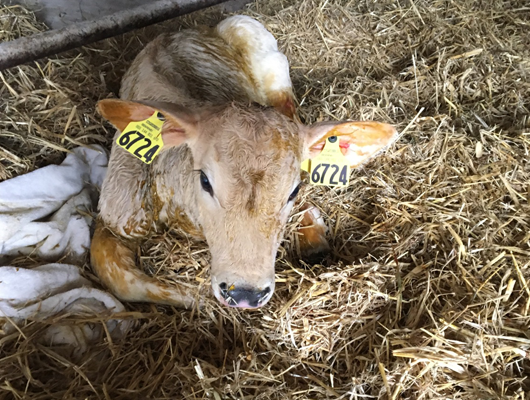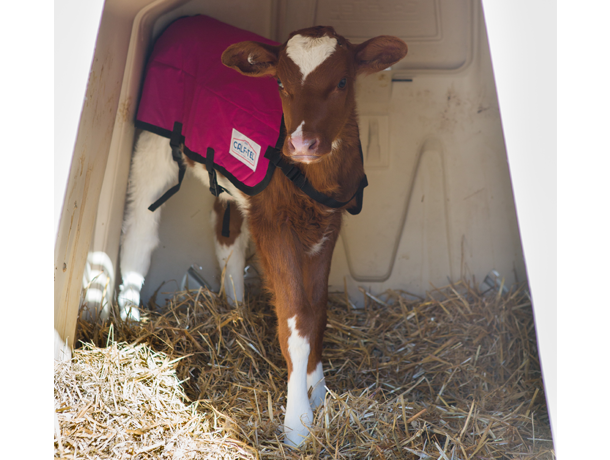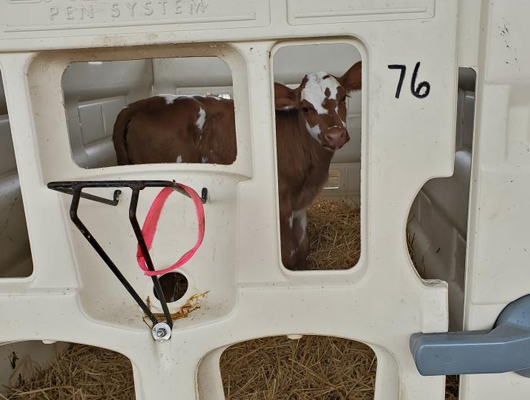We have all likely experienced those calves that are slow to take their first breath, slow to nurse, or have some swelling in their tongue or face after a difficult birth. These newborns require extra time and attention over the early weeks of life to make sure they overcome the added stress of a difficult birth. In dairy cattle, it has been estimated that 75 percent of newborn calf mortality occurs within an hour of birth, (Smith) but proper care of calves experiencing a difficult birth can certainly help reduce this number.
What is Dystocia in Calves?
Dystocia is defined as difficult or delayed calving and some factors can include calf size, pelvic size of the dam, calf presentation, uterine torsion or inadequate cervical dilation. The most common cause is a calf that is too large for the dam’s pelvic size, as we can see in heifers trying to deliver large bull calves. It is important to note that the inappropriate timing of human assistance or excessive force during delivery can also cause added stress or trauma to the calf.
The 3 Steps to Begin Care for Calves with Dystocia
There are three key elements to caring for calves that have just experienced a difficult delivery:
- Breathing
- Feeding colostrum
- Keeping them warm
Breathing
The first key to life outside the uterus is taking that first breath and inflating the lungs to get the blood oxygenated. After a difficult birth, the first assistance that should be offered is to set the newborn upright on its sternum immediately, and clear their nose and mouth of any fluid carefully with either clean hands or a bulb syringe. Sometimes, placing a finger or piece of clean straw in the nose to create a tickle can cause the calf to draw a deep breath and expand the lungs. Never hang a calf upside down or spin it around, these procedures increase the pressure in the chest cavity and make it even harder for the lungs to fully inflate. (Arnold)

If a calf is slow to have active, steady breathing in the first 30 seconds of life, it is imperative to continue cleaning the airway. It is a cow’s instinct to lick the calf almost immediately after birth, but rubbing the dystocia calf vigorously with a towel can also help stimulate its heart and lungs. Newborn calves will normally lift their own head within three minutes, sit up within five minutes, and stand within an hour. (Smith)
Make sure that all members of your maternity team clearly understand normal cow and calf behaviors after delivery and not just how to deliver the calf that is not presenting normally for delivery.
One of the most important measures to help a newborn calf inflate its lungs is to set it up on its sternum, as pictured in this photo. Rubbing the calf with a clean towel can also help stimulate their breathing. The author stopped the toweling and took this photo after this calf started to breathe regularly and hold her head up.
Feeding Colostrum
Second, the most important piece of the calf survival equation is colostrum. Calves should receive four quarts of high-quality colostrum within the first six hours after birth. Calves that have been wedged in the pelvic canal for a time may be born with a swollen head or tongue. If this condition clearly prevents suckling, it is imperative that colostrum be delivered via esophageal tube feeder.
Compromised calves “tend to have lower oxygen delivery to tissues and will absorb immunoglobulins over a longer period of time; so, it is worth providing an extra colostrum feeding to assure the calf has the best chance of good colostral immunoglobulin transfer,” notes the Bovine Veterinarian website.
If the calf is willing to suckle, take the time to work at getting them to drink from a nursing bottle. This may require coming back to them several times in the first four to six hours, but the effort allows for more stimulation of the calf, along with the chance to rub them again with a towel and encourage them to stand. (Leadley)
Colostrum contains immunoglobulins that establish the calf’s immune system, along with sugars and vitamins vital to their early nutrition. Delaying the delivery of colostrum to dystocia calves can result in a failure of passive transfer, increasing the likelihood of sickness and infectious diseases in the days ahead.
Keeping Them Warm
And finally, calves that deliver normally will maintain their body temperature by shivering and mobilizing energy from fat tissue in their body, while their activities of learning to stand, walk and nurse a bottle will also generate body heat for them. Dystocia calves may not have adequate oxygenation to mobilize their fat, are less active and will struggle to stay warm.

These calves should be monitored closely and placed in a warm, dry space until they are active and suckling on their own. Once the calf is dry, placing them in a Calf-Tel calf jacket containing 200 grams of Thinsulate can also help keep them warm. Many inexpensive calf jackets on the market are filled with polyfil, a product that doesn’t offer real insulating value to the calf.
Other Signs of Dystocia to Look Out For
Besides those already mentioned, other signs that can indicate calf distress during delivery can include hemorrhages or red spots in the eye, cyanotic or blue mucous membranes, irregular breathing, or meconium staining at birth. This yellowish-brown staining results from oxygen deprivation while still in the amniotic sac, which causes colon contractions and pushes the meconium, or first “manure”, out of the calf. These calves will have a challenge to stand, nurse and absorb immunoglobulins. (Smith)
Longterm Care Needs for Calves with Dystocia
It is recommended to monitor dystocia calves closely for two to three weeks. Farms use different methods to identify them, including using colored duct tape on the hutch or pen or even attaching a mailbox flag to their housing. Other methods have included a colored leg band fastened to the fence of the hutch, marking the calf with a certain color of all-weather livestock marker. Another farm I visited kept difficult birth calves in their own special area, closest to the calf barn office, so they could be monitored more closely multiple times each day.
Colored bands are an easy-to-see indicator often used on plastic Calf-Tel housing to indicate a special needs calf for extra observation.

Whatever the method used to identify these vulnerable calves, work with the herd veterinarian to develop a strategy and protocols for their care. A well-trained, caring and attentive team can make a big difference in getting dystocia calves off to the best start possible.
About the Author
Kelly Driver has been involved in the New York dairy industry all her life. In addition to raising dairy calves and replacement heifers, she is the Northeast Territory Manager for Calf-Tel. Feel free to contact her at kellydriver@hampelcorp.com with your calf questions or suggest a topic you would like covered in a future blog.
Sources
Arnold, Dr. Michelle. (2015, January 14). Emergency calf management after dystocia. Drovers. Retrieved from https://www.drovers.com/article/emergency-calf-man…
Bovine Veterinarian. (2013, January 1). How to manage dystocia calves. Retrieved from https://www.bovinevetonline.com/article/how-manage…
Leadley, Dr. Sam. (Internet). Dystocia (hard delivery) calf care. Retrieved from http://www.atticacows.com/library/newsletters/Dyst… Smith, Dr. Geof. (2018, June 14). Manage newborn calves after dystocia. Ag Update. Retrieved from https://www.agupdate.com/manage-newborn-calves-aft
Courtesy of our dealer – CRI REPRODUCCIÓN ANIMAL MÉXICO SA DE CV.
